Cisco CRS Carrier Routing System 16-Slot Line Card Chassis Unpacking, Moving, and Securing Guide
Available Languages
Contents
- Cisco CRS Carrier Routing System 16-Slot Line Card Chassis Unpacking, Moving, and Securing Guide
- Contents
- Documentation Overview
- Objective
- Audience
- Related Documentation
- Hardware Documents
- Software Documents
- Changes to This Document
- Obtaining Documentation and Submitting a Service Request
- Chassis Unpacking Overview
- Chassis Packaging
- Key Chassis Specifications
- Dolly Specifications
- Safety Guidelines
- Verifying the Securing Location
- Preventing Electrostatic Discharge
- Unpacking the Dolly
- Prerequisites
- Required Tools and Equipment
- Steps
- Unpacking the Cisco CRS 16-Slot Chassis
- Required Tools and Equipment
- Prepare the Chassis For Unpacking
- Steps
- Unpacking the Chassis
- Steps
- Attaching the Dolly to the Chassis and Removing the Chassis Pallet
- Prerequisites
- Required Tools and Equipment
- Steps
- Moving the Cisco CRS 16-Slot Line Card Chassis
- Important Notice About Transporting the Chassis
- Moving Guidelines for Chassis and Dolly
- Verifying the Move Path
- Moving the Unpacked Chassis
- Prerequisites
- Steps
- Securing the Chassis
- Site Preparation
- Bolt Hole Templates
- Securing the Chassis to the Floor
- Prerequisites
- Required Tools and Equipment
- Steps
- Modifying the Dolly Configuration
- Prerequisites
- Required Tools and Equipment
- Steps
- Installing the Alternate Chassis Floor-Mounting Kit
- Prerequisites
- Required Tools and Equipment
- Steps
- Unpacking Chassis Component Shipping Pallets
- Steps
- Component Return Information
Cisco CRS Carrier Routing System 16-Slot Line Card Chassis Unpacking, Moving, and Securing Guide
This guide provides instructions for unpacking the Cisco CRS 16-Slot Line Card Chassis (LCC) and its components, moving the chassis to its permanent location. The companion document to this guide is Cisco CRS Carrier Routing System 16-Slot Line Card Chassis Site Planning Guide, which describes how to plan and prepare your site facilities for the installation of a 16-slot line card chassis.
The Cisco CRS 16-slot LCC is a highly scalable routing platform designed for efficient service-provider point-of-presence (POP) evolution as the IP network grows into a multiservices network. The Cisco CRS 16-slot LCC, in the initial release, is constructed from a single line card chassis, a mechanical enclosure. The enclosure contains 16 slots for PLIMs or SIPs/SPAs (at the front), 16 slots for MSCs (at the rear), and eight switch fabric card slots (at the rear, half-height).
The Cisco CRS Series 16-slot LCC supports 40 GB, 140 GB, and 200 GB fabric cards and line cards, as follows:
- The Cisco CRS-1 Carrier Routing System uses fabric cards designed for 40 GB operation (FC/S cards).
- The Cisco CRS-3 Carrier Routing System uses fabric cards designed for 140 GB operation (FC-140G/S cards).
- The Cisco CRS-X Carrier Routing System uses fabric cards designed for 200 GB operation (FC-400G/S cards in 200G mode).
A mixture of 40G, 140G, and 200G fabric cards is not a supported mode of operation.
Note
Throughout this document, the generic term Cisco CRS Carrier Routing system refers to the Cisco CRS-1, Cisco CRS-3, and Cisco CRS-X Carrier Routing Systems, unless otherwise specified.Contents
This document presents the following topics:
- Obtaining Documentation and Submitting a Service Request
- Chassis Unpacking Overview
- Unpacking the Dolly
- Unpacking the Cisco CRS 16-Slot Chassis
- Attaching the Dolly to the Chassis and Removing the Chassis Pallet
- Moving the Cisco CRS 16-Slot Line Card Chassis
- Securing the Chassis
- Modifying the Dolly Configuration
- Installing the Alternate Chassis Floor-Mounting Kit
- Unpacking Chassis Component Shipping Pallets
- Component Return Information
Documentation Overview
This section presents the following topics:
Objective
This document provides instructions for unpacking the Cisco CRS 16-slot LCC and its components, attaching the dolly, moving the chassis safely, and securing the chassis to the floor. This document does not provide background information and basic theory-of-operation for anyone wanting to understand the Cisco CRS Carrier Routing System.
Audience
This document is intended for those who unpack the Cisco CRS 16-slot LCC and Cisco installation partners who are responsible for moving and securing the LCC. No additional knowledge of routing or the Cisco IOS XR software is assumed.
Related Documentation
For complete planning, installation, and configuration information, refer to the following documents:
Hardware Documents
- Cisco CRS Carrier Routing System 16-Slot Line Card Chassis Site Planning Guide
- Cisco CRS Carrier Routing System 16-Slot Line Card Chassis System Description
- Cisco CRS Carrier Routing System 16-Slot Line Card Chassis Installation Guide
- Cisco CRS Fiber-Optic Cleaning Kit Quick Start Guide
- Cisco CRS Carrier Routing System Hardware Documentation Guide
- Cisco CRS-1 Carrier Routing System to Cisco CRS-3 Carrier Routing System Migration Guide
- Cisco CRS Carrier Routing System Regulatory Compliance and Safety Information
Software Documents
For a complete listing of software documentation available, see About Cisco IOS XR Software Documentation , available online at:
http://cisco.com/en/US/products/ps5763/tsd_products_support_series_home.html
Changes to This Document
This table lists the technical changes made to this document since it was first printed.
Table 1 Changes to This Document Revision
Date
Change Summary
OL-31656-01
January 2014
Added updates to support the Cisco CRS-X, which includes new line cards, switch fabric cards, and PLIMs.
78-17535-10
August 2011
Updated this document with minor editorial changes.
78-17535-09
May 2011
Updated the chassis moving content. Reorganized sections in the document. Updated illustrations.
78-17535-08
March 2011
Updated this document with unpacking information and graphics. Added CRS-1 and CRS-3 information. Also made minor editorial changes.
78-17535-07
October 2010
Updated this document with minor editorial changes and information for the new MSC140 and FP140 line cards was added.
78-17535-06
December 2009
Updated this document with new chassis move path specifications, dolly moving safety shipping information, and chassis weight changes for shipping.
78-17535-05
August 2009
Updated this document with new chassis shipping information. See Chassis Unpacking Overview, Key Chassis Specifications, and the caution note about chassis weight.
78-17535-04 B0
February 2008
Updated this document with technical corrections.
78-17535-04
September 2007
Added a new section on Installing the Alternate Chassis Floor-Mounting Kitfor the NEBS-compliant chassis. This section replaces the previous section, which documented the pre-NEBS-compliant chassis.
78-17535-03 B0
March 2007
Modified the Installing the Alternate Chassis Floor-Mounting Kit section with new information and technical corrections. The term “outrigger kit” was changed to “alternate chassis floor-mounting kit.”
78-17535-02
September 2006
Updated this document with technical corrections.
78-17535-01
April 2006
Initial release of this document
Obtaining Documentation and Submitting a Service Request
For information on obtaining documentation, submitting a service request, and gathering additional information, see the monthly What’s New in Cisco Product Documentation , which also lists all new and revised Cisco technical documentation, at:
http://www.cisco.com/en/US/docs/general/whatsnew/whatsnew.html
Subscribe to the What’s New in Cisco Product Documentation as a Really Simple Syndication (RSS) feed and set content to be delivered directly to your desktop using a reader application. The RSS feeds are a free service and Cisco currently supports RSS version 2.0.
Chassis Unpacking Overview
This section provides information about the Cisco 16-slot chassis before you unpack it and transport it from the loading dock to the final installation location.
This section contains the following topics:
Chassis Packaging
Depending on the number of options you ordered, the Cisco CRS router arrives packaged in several shipping crates and pallets. The line card chassis is shipped in several crates that reduce the potential for product damage during routine material handling and shipment. To protect the chassis:
- Always store the chassis in its original packaging in an upright position.
- If you plan to store chassis components before the installation, be sure to store the components carefully and in their original shipping containers to prevent accidental damage.
Each shipping box has a yellow label on the outside of the box identifying the number of boxes in your shipment. For example 1 of 6, 4 of 6. The 16-slot chassis is shipped on a pallet by itself and arrives inside a polyethylene bag enclosed in a plywood box, held in place by steel clips. Other system components are shipped in separate crates and can arrive at the final chassis site at different times.
For complete details on the contents of your shipment, see the inventory and parts identification label on the crate as shown in this figure. The total number of pallets depend on the details of the options you ordered with each package containing a label that describes the contents.
Note
Crate numbering for chassis packaging is for reference only. This list is only a sample of what a CRS FCC shipment contains. For complete details on the contents of each pallet, see the shipping and parts identification label on the pallet or shipping manifest.
- Installation kit (crate 1)—Contains the drill hole template and other installation kit items.
- Dolly pallet (crate 2)—Contains two dolly units in the 90-degree position (see Figure 2).
Note
In the event that the dolly supplied by Cisco is not the appropriate method of transportation, consult Cisco Technical Staff to determine a method of transportation appropriate for the site. Ensure that the alternate moving device is capable of moving the chassis safely, supporting the weight of the chassis, and is capable of preventing the chassis from tipping.
- Chassis pallet (crate 3)—Contains the chassis itself encased in a polyethylene bag and covered with a wooden packing crate held together with metal brackets. The chassis is the first shipping box to be unpacked and transported to its final installation location.
The chassis is shipped with the fan trays, air filter, switch fabric, route processor, and fan controller cards already installed. The modular services card (MSC) and physical layer interface module (PLIM) slots are populated with blanks and impedance carriers.
- Power components pallet (crate 4)—Contains the power components, including the power shelves, PMs, PEMs, alarm modules), and power bezel with retainer frame.
- Primary card pallet (crate 5)—Contains the MSCs, PLIMs or SPAs/SIPs.
- Cosmetics pallet (crate 6)—Contains the exterior cosmetic components for the chassis. Default shipment for the LCC includes the exterior cosmetic components that are installed on a standalone chassis. (If you are installing an LCC as part of a multichassis system, you will need to order the exterior components separately.)
Key Chassis Specifications
This table lists the specifications for the Cisco CRS 16-slot LCC (as they are shipped without packaging).
Table 2 Chassis Specifications Specification
Value
Physical dimensions (without packaging):
Height
80.0 in. (203 cm)
Depth (without cosmetics)
36.0 in. (91.4 cm)
Width
23.6 in. (59.9 cm)
Weight (without packaging):
CRS-16 as-shipped weight: 1175 lb (533 kg) (Est.)CRS-16 spare chassis weight: 1044 lb (473.6 kg) (Est.)
Dolly Specifications
The dolly that is available for the Cisco CRS 16-slot LCC is flexible enough to meet several challenges common when first positioning a chassis of this size and weight. Such challenges include limited hallway or doorway width, doorway thresholds, ramps, and tight corners along the transport route. To overcome these challenges, use the dolly in either of the following configurations:
- 90-degree configuration— The dolly assemblies are shipped in this configuration. In some cases this configuration is needed to transport the chassis. Use the 90-degree to move the chassis off of the pallet. Extra care should be used in this configuration to ensure that the chassis does not tip during transport.
- 180-degree configuration— This configuration is a more stable configuration for transporting the chassis. The 180-degree position is the recommended configuration for moving the chassis.
Both configurations are acceptable to transport the as-shipped chassis.
This table lists the specifications for the dolly.
Table 3 Dolly Specifications Specification
Value
Weight (each component)
126 lb (57.3 kg)
Maximum recommended height from floor
1.5 inches (3.81 cm)
Note
In the event that the dolly supplied by Cisco is not the appropriate method of transportation, consult Cisco Technical Staff to determine a method of transportation appropriate for the site. Ensure that the alternate moving device is capable of moving the chassis safely, supporting the weight of the chassis, and is capable of preventing the chassis from tipping.Safety Guidelines
CautionBefore you perform any procedure in this document, review the safety guidelines in this section to avoid injuring yourself or damaging the equipment.
The following guidelines are for your safety and to protect equipment. Guidelines do not include all hazards. Be alert.
Note
Review the safety warnings listed in Regulatory Compliance and Safety Information for the Cisco CRS Carrier Routing System before installing, configuring, or troubleshooting any installed card.
- Never attempt to lift an object that might be too heavy for you to lift by yourself.
- Keep the work area clear and dust free during and after installation. Do not allow dirt or debris to enter into any laser-based components.
- Keep tools and router components away from walk areas.
- Do not wear loose clothing, jewelry, and other items that could get caught in the router while working with OIMs, and their associated components.
- Use Cisco equipment in accordance with its specifications and product-usage instructions.
- Do not work alone if potentially hazardous conditions exist.
Verifying the Securing Location
Verifying the recommended space ensures that you have enough space available to perform the initial installation of the chassis and its components.
Before moving the chassis into position, make sure that you have properly prepared the site so that there is sufficient room for installation and maintenance.
For additional details on making your site ready for the chassis, see Cisco CRS Carrier Routing System 16-Slot Line Card Chassis Site Planning Guide and Cisco CRS Carrier Routing System Multishelf System Site Planning Guide .
Preventing Electrostatic Discharge
Electrostatic discharge (ESD) damage, which can occur when electronic cards or components are improperly handled, results in complete or intermittent failures. We recommend use of an ESD-preventive strap whenever you handle network equipment or one of its components.
Following are guidelines for preventing ESD damage:
- Always use an ESD-preventive wrist or ankle strap, and ensure that it makes good skin contact. Connect the equipment end of the connection cord to an ESD connection socket on the router or to a bare metal surface on the chassis.
- Handle a card by its ejector levers, when applicable, or its metal carrier only; avoid touching the board or connector pins.
- Place a card removed from the chassis, component side up, on an antistatic surface or in a static-shielding bag. If you plan to return the component to the factory, immediately place it in a static-shielding bag.
- Avoid contact between the card and clothing. The wrist strap protects the board from only ESD voltage on the body: ESD voltage on clothing can still cause damage.
CautionWhen unpacking and setting parts aside, it is important to set them either in their original antistatic packaging or on an antistatic mat to avoid static discharge.
Unpacking the Dolly
The dolly is a Cisco-supplied orderable item. The shipping crate contains the dolly units, positioned in the 90 degree configuration as shown in Figure 2. This section describes how to unpack and position the dollies.
See Figure 4 for an illustration of the dolly used to move the Cisco CRS Line Card Chassis.
Required Tools and Equipment
You need the following tools (only used to remove packaging) to perform this task:
- 3/8-in. ratchet wrench
- 9/16-in. socket and a 5/8-in. socket
- Phillips #2 screwdriver (used to remove the clip from the dolly crate)
CautionThe dolly should be used only for transporting the as-shipped chassis.
Steps
Procedure
Step 1 Carefully move the pallet containing the dolly to the location where you plan to unpack it. The dolly arrives as two separate, identical units, one unit each for the front and back of the chassis. Step 2 Remove the clip tool from the dolly shipping crate as shown in this figure. Step 3 Remove front panel from dolly crate. Swing open and lift off. Step 4 Using the 3/8-in. ratchet wrench with 5/8-in. socket remove the two holding bolts from each side at the bottom of the dolly pallet base as shown in Figure 1. Step 5 With two people, one on each side of the dolly shipping crate, tilt crate back and lift off pallet, then set the crate carefully aside as shown in this figure. Step 6 Using the 3/8-in. ratchet wrench with 5/8-in. socket remove the two bolts and the dolly stopper. See this figure. Step 7 Release the caster brakes and remove dolly from pallet.
Caution Each dolly unit weighs approximately 126 lb (57 kg). We recommend that at least two people remove the unit from the pallet.
This figure shows the dolly 90-degree configuration with labels to components.
1
Dolly handle label
6
Caster antirotation pins
2
Swing component for dolly (used to change the dolly configuration)
7
Label showing how to attach dolly to chassis
3
Lift bracket bolts
8
Move height calibration label
4
Lift brackets
9
Lifting cranks
5
Brakes
This figure shows the dolly 180-degree configuration. Both dolly units are identical.
What to Do Next
After performing this task, unpack the chassis. See the Unpacking the Chassis section for more information.
Unpacking the Cisco CRS 16-Slot Chassis
This section describe:
Required Tools and Equipment
You need a:
- 3/8-in. ratchet wrench
- 10-mm hex bit (provided by Cisco included in the dolly packaging)
- 11/16-in. socket (to remove the top wood and frame cushion system)
- Ladder or step platform
Prepare the Chassis For Unpacking
The chassis is shipped on a pallet by itself in a plywood box. The chassis is unpacked before all other shipping boxes, except for the dolly lifting device.
Steps
Procedure
Step 1 Locate a large area to accommodate and remove the chassis crate. Step 2 Go to the section, Unpacking the Chassis.
Caution The crated Cisco CRS 16-slot LCC is heavy and tall and it must be handled carefully to eliminate the risk of tipping the chassis over. We recommend that at least two people handle and move the chassis.
Note The crated CRS 16-slot chassis is moved first. All other component shipping boxes can remain in the receiving area or in an area, as space allows, at your site, until the chassis is secured in its final location.
Unpacking the Chassis
This section describes the steps to unpack the chassis from the shipping crate. You should unpack the chassis and chassis components in the following order:
This table lists the physical characteristics of the chassis shipping crate.
Steps
Procedure
What to Do Next
After performing this task, go to the next section Attaching the Dolly to the Chassis and Removing the Chassis Pallet.
Attaching the Dolly to the Chassis and Removing the Chassis Pallet
This section describes how to attach the dolly to the Cisco CRS 16-slot LCC to remove the chassis shipping pallet and prepare to move the chassis into place. Only the 90-degree dolly configuration is used to remove the chassis from the pallet.
This figure shows the dolly instruction label on the inside component of the dolly. Refer to this graphic when performing the steps to attach the dolly to the chassis in this section.
Required Tools and Equipment
You need the following tools and part to perform this task:
- 2.5mm hex key (to remove the covers)
- 14-mm socket
- 3/8-in. ratchet wrench with 6-in. extension
- 12-mm hex bit (included in the dolly packaging)
- Dolly (Cisco product number CRS-16-LIFT/B=)
Steps
Procedure
Step 1 Using a 2.5mm hex key, remove the M4 x 14mm long button-head screws from the floor mount corner covers at the base of chassis to expose the floor mounting holes. This figure shows a section of the chassis with the corner covers being removed and exposing the floor mounting holes. (Follow the same procedure for all four corner covers.) Step 2 Using a hex head socket and wrench, remove the four bolts (½-18 x 3.5 in. long hex-head) that connect the pallet to each corner of the chassis base as shown in this figure. Step 3 Use the 3/8-in. ratchet wrench with 12-mm hex bit (provided by Cisco) to remove the two dolly-to-chassis lift brackets (see this figure) and set them carefully aside. Repeat this step for the second dolly unit.
Note The lift brackets must be attached to the chassis first. Step 4 Select a lift bracket. There are two identical lift brackets for the right front and left rear and two identical lift brackets for the right rear and left front (See this figure).
1
From left to right—left front and right front lift brackets
4
Two M14 x 50-mm socket-head cap screws s (used to bolt the front and rear lift brackets to the chassis)
2
Side pins on each lift bracket (inserted into the chassis)
5
Four M14 x 30-mm socket-head cap screws (used to bolt the front and rear lift brackets to the dolly)
3
From left to right—Right rear and left rear lift brackets
Step 5 Attach lift brackets to chassis. Align and insert the side pins of the lift bracket to the lower left side of the front (PLIM) side of the chassis. Repeat this step with the “right” lift bracket on the lower right side of the front (PLIM) side of the chassis. This figure shows an oblique view of attaching the lift brackets to the chassis. This figure shows the top view of attaching the lift brackets to the chassis.
Step 6 Bolt the lift brackets to the dolly. Insert the 50-mm socket-head cap screw (longer screw, as shown in Figure 4) that connects the left lift bracket to the bolt block on the lower front corner of the front (PLIM) side of the chassis, and use the 14-mm hex drive socket to tighten it. Repeat this step for the right lift bracket to insert the two bolts that bolt the lift bracket to the dolly. Step 7 Repeat step 5 and step 6 for the rear (MSC) side of the chassis. Step 8 Attach the dolly to the chassis lift brackets:
Step 9 After all bolts are secured, remove the chassis pallet following these steps:
What to Do Next
After performing this task, move the chassis.
Moving the Cisco CRS 16-Slot Line Card Chassis
This section describes the things to consider as you move the chassis from the loading dock to the installation site. This section contains the following topics:
Important Notice About Transporting the Chassis
Either a fork lift or pallet jack can be used to transport a crated chassis only.
Throughout this document we refer to the dolly (supplied by Cisco) as the required means to transport the uncrated chassis from the shipping dock to the chassis final location.
Note
In the event that the dolly supplied by Cisco is not the appropriate method of transportation, consult Cisco Technical Staff to determine a method of transportation appropriate for the site. Ensure that the alternate moving device is capable of moving the chassis safely, supporting the weight of the chassis, and is capable of preventing the chassis from tipping.
CautionWhen using any type of device to transport the chassis, exercise extreme caution and follow proper safety practices.
Moving Guidelines for Chassis and Dolly
Caution
The uncrated Cisco CRS 16-slot LCC is heavy and tall and it must be handled carefully to eliminate the risk of tipping the chassis over. We recommend that at least two people handle and move the chassis.
When you use the dolly or move the as-shipped Cisco CRS 16-slot LCC, follow these guidelines:
- When using the dolly to move the as-shipped chassis between locations , ensure that the chassis is free of MSC and PLIM cards, and power components.
- When raising or lowering the chassis , follow these guidelines:
- Make sure that you have at least one person on each side of the chassis to turn the lifting cranks on the dolly as simultaneously as possible.
- Raise or lower the chassis only on a level surface.
- Make sure that the caster brakes and antirotation pins are in the locked position.
- Keep the casters on the floor at all times when you are raising or lowering the chassis.
- Attempt to keep the chassis itself as level as possible when raising or lowering it with the dolly.
- Use the height label on the dolly to make sure that you have the correct amount of ground clearance. (The label shows the recommended transport chassis engagement height, the height that is not to be exceeded, and to ensure correct alignment between both dolly wheel assemblies.)
- When moving the chassis in a hallway (standard hallway is 5 feet) or through isles using a dolly , follow these guidelines:
- Make sure that you have at least two people to transport the chassis. Never transport the chassis by yourself.
- Use the dolly in the 180-degree configuration whenever possible when you move the chassis. This configuration requires you to have passageways at least 50 inches in width to accommodate the combined dolly and chassis width.
- Use the dolly in the 90-degree configuration if your site restrictions require it. If hallway constraints require you to use the 90-degree dolly configuration (24 inches), the chassis is more likely to tip, so use extra care when transporting the chassis in that configuration.
- Dolly is used to transport the chassis. To reduce the risk of dolly instability, chassis damage, or personal injury, do not raise the equipment more than 1 inch (2.54 cm) above the floor during transportation.
- Dolly can be used to transport the chassis over thresholds up to 1.5 inches.
- When transporting the chassis on a ramp , follow these guidelines:
- Make sure that you have at least two people to transport the chassis up and down a ramp. Position one person in the front of the chassis to pull and one person at the rear of chassis to push. It may be helpful to have an additional person to help steer the chassis.
- Dolly is optimized to move the chassis on flat surfaces. It is not designed to move the chassis on ramps greater than 1 inch of rise for every 6 inches of run. If the ramp exceeds this maximum limit, consult with Cisco Technical Staff.
- Exercise extreme caution when moving chassis up an incline of any angle.
Caution
Use the recommended 180-degree configuration to transport a chassis. If the 90-degree configuration is used, then the chassis is more likely to tip. Use caution and take extra care in rolling the chassis up a ramp. Always follow proper safety practices whenever moving a CRS chassis.
Note
The following warning statements are also documented in the Cisco Regulatory Compliance and Safety Information for the Cisco CRS Carrier Routing System .
Warning
Cisco does NOT recommend moving a fully populated chassis.
Warning
This dolly is designed only for the temporary transportation of the Cisco equipment listed here. Do not use it with any other device or for any other purpose. Cisco equipment designed for use with the dolly: Cisco CRS fabric card chassis and line card chassis (CRS-FCC, CRS-16-LCC). Statement 356
Warning
Do not permanently locate the equipment on the dolly. Safely store the dolly after use. Statement 357
Warning
To reduce the risk of dolly instability, chassis damage, or personal injury, do not raise the equipment more than 1 inch (2.54 cm) above the floor during transportation. Statement 358
Warning
This dolly is designed to transport the equipment over short distances only. Statement 359
Warning
In order to reduce the risk of chassis damage or personal injury when replacing a fully-loaded, existing chassis, do not move the chassis in a configuration that is greater than the as-shipped chassis. Before attaching the dolly and moving the chassis, remove power modules, PLIMs, and MSCs from the chassis. Statement 367
Warning
To reduce the risk of dolly instability, chassis damage, or personal injury, do not transport the equipment with the dolly raised higher than the maximum transport height shown on the dolly label, and do not raise the equipment higher than required to remove the shipping pallet. For information about maximum dolly heights, see the dolly instructions in this document. Statement 368
Caution
Dolly wheel casters and anti-rotation pins should be in the locked position when the dolly is not in use.
Verifying the Move Path
Before moving the chassis, it is critical that you verify that the path that you are planning to use to move the chassis to its final location can accommodate the chassis size and weight and the restrictions of the chassis when using the dolly (see the Dolly Specifications).
See this table below for a list of the restrictions for your move path, and verify that you have sufficient room for the entire move path prior to moving the chassis.
Table 5 CRS 16-slot Chassis Move-Path Specifications Specification
Value
Height (on dolly, with recommended 1 in. raise)
81 in. (205 cm)
Depth (on dolly, 90-degree dolly position)
70 in. (178 cm)
Depth (on dolly, 180-degree dolly position)
48 in. (122 cm)
Width (on dolly, 90-degree dolly position)
23.6 in. (60 cm)
Width (on dolly, 180-degree dolly position)
44 in. (112 cm)
Weight of chassis (as shipped, packaging removed)
1175 lb (533 kg), Estimated
Weight of dolly (both units)
252 lb (114.5 kg)
Maximum recommended height from floor (for chassis on dolly)
1.5 in. (3.8 cm)
Note
Allow a minimum gap of between 4 to 6 in. (10 to 15 cm) on each side of the combined chassis and dolly when moving it.This figure shows the recommended minimum space to turn the chassis on the dolly in its 90-degree and 180-degree configuration.
1
Width (on dolly, 180-degree position) 44 in. (112 cm)
4
Width (on dolly, 90-degree position) 24 in. (60 cm)
2
Depth (on dolly, 180-degree position) 48 in. (122 cm)
5
Depth (on dolly, 90-degree position) 70 in. (178 cm)
3
Turn radius (on dolly, 180-degree position) 33 in. (83 cm)
6
Turn radius (on dolly, 90-degree position) 37 in. (94cm)
This table provides the dolly width and the recommended aisle width turning radius for the 90-degree and 180-degree dolly configuration.
Table 6 Chassis Turning Recommendations Dolly Configuration
Width of Combined Chassis and Dolly
Recommended Aisle Width
90-degree dolly position
24 in. (60 cm)
32 in. (81 cm)*
180-degree dolly position
44 in. (112 cm)
52 in. (132 cm)
*Aisle width may be different when transporting the chassis around a corner.
This figure is a top view of the minimum aisle space required to install the Cisco CRS 16-slot line card chassis without using the dolly supplied by Cisco.
Moving the Unpacked Chassis
Prerequisites
Before performing this task, make sure that the dolly is in the correct configuration, is firmly attached to the chassis, and that the dolly brakes are in the locked position.
Note
If a dolly configuration change is required, the go to the section, Modifying the Dolly Configuration.Steps
Procedure
Step 1 With a person on each side of the chassis, turn all four lifting cranks of the dolly slowly clockwise. Lift the dolly to the “Transport” marking on the height label on each lift assembly leg. The dolly can be used to transport the chassis. To reduce the risk of dolly instability, chassis damage, or personal injury, do not raise the equipment more than 1 in. (2.54 cm) above the floor during transportation which is the standard recommendation for flat surfaces and thresholds.
Note The dolly has four separate lifting cranks, each of which works independently. It is best to turn each lifting crank simultaneously when lifting the chassis to keep the chassis as level as possible so as to not put undue stress on the chassis frame or dolly and to reduce the risk of tipping.
Caution The Cisco CRS 16-slot LCC is heavy and tall, and it must be handled carefully to eliminate the risk of tipping the chassis over. We recommend that at least two people handle and move the chassis.
Note Remove physical layer interface modules (PLIMs), modular service cards (MSCs), and power shelves before you move the chassis, if they are installed. There is less chance of tipping when no cards, modules, or shelves are installed.
Note The 180-degree position is the recommended configuration for moving the chassis. If needed because of site requirements, rotate the dolly to the 90-degree position. If you are transporting in a 90-degree configuration, then have at least two people moving the chassis to prevent any transporting hazard. See the Modifying the Dolly Configuration section for further information.
Note You must lower the chassis completely to the floor before rotating the outrigger legs to minimize the risk of tipping. When you have rotated the dolly, raise the chassis again. See the Modifying the Dolly Configuration section for further information. Step 2 Unlock the dolly caster antirotation and brake systems.
Note The dolly is optimized to move the chassis on flat surfaces. It is not designed to move the chassis up stairs, over curbs, up ramps, or over bumps more than 1.5 inches high (such as door thresholds). Step 3 Use at least two people to transport the chassis up any ramp. Position one person in the front of the chassis to pull and one person at the rear of chassis to push. It may be helpful to have an additional person to help steer the chassis. Step 4 Roll the chassis carefully into position. This figure shows a typical floor plan from the top of the chassis (see the Cisco CRS Carrier Routing System 16-Slot Line Card Chassis Site Planning Guide for details). Step 5 Remove the dolly.
What to Do Next
After performing this task, secure the chassis.
Warning
Do not permanently locate the equipment on the dolly. Safely store the dolly after use. Statement 357
Securing the Chassis
This section presents the following topics:
Site Preparation
Before moving the chassis into place and securing it, you must make sure that your site is prepared. Because of its size and weight, the chassis must be securely bolted to the floor. Several possible bolting configurations exist for the chassis, including using the optional alternate chassis floor-mounting kit. Drill hole templates are provided for the various securing options. See the Cisco CRS Carrier Routing System 16-Slot Line Card Chassis Site Planning Guide for space planning.
Bolt Hole Templates
Cisco provides two bolt hole layout templates to help you determine where to install the system:
- Mylar template (CRS-LCC-FLOORTEMP) shows the chassis footprint, door swings, and required clearances to remove and replace chassis components. You can use this template to plan the aisle space required for the installation and maintenance of a Cisco CRS 16-slot LCC.
- Aluminum plate template (CRS-LCC-DRILLTEMP) (is a hole drilling template) that identifies the chassis footprint and the pattern of holes that must be drilled into the floor for the mounting hardware that secures the chassis to the floor.
Complete information about the templates and floor plans, clearance information, and planning for future space needs, is included in Cisco CRS Carrier Routing System 16-Slot Line Card Chassis Site Planning Guide.
Securing the Chassis to the Floor
This section describes how to secure the Cisco CRS 16-slot LCC to a concrete floor. The chassis is shipped with a drill hole template (CRS-LCC-DRILLTEMP) to assist you in putting the bolts in the proper position on the floor. The template is used for both raised floors and slabs. The drill hole template identifies primary, secondary and alternate mounting locations for securing the chassis to the floor. Whenever possible, use the:
- Primary mounting locations
- Second and alternate locations only when the primary locations are not available
If alternate mounting locations are used, an alternate chassis mounting kit (CRS-16-LCC-ALTMNT) (orderable from Cisco) needs to be installed on the chassis
The instructions in this section are specific to securing the chassis to a concrete floor. The instructions for securing the chassis to a raised floor vary from site to site, depending on such details as whether your floor needs additional support (as local practice applies for raised floors), where (depending on the location of the floor tiles) the bolt holes need to be and so on. Work with your facilities representative to determine your needs for your particular site.
Required Tools and Equipment
You need the following parts to perform this task:
- 3/8-in. ratchet wrench
- Set of standard and metric sockets
- Drill and bits for masonry and wood
Note
The full list of tools depends on the anchor bolt kit you use. See the documentation for your anchor bolt kit for details.Steps
Procedure
Step 1 Using the drill hole template, drill pilot holes into the floor at the identified locations. Step 2 Refer to your mounting kit instructions for anchoring hardware to the floor. Remove the drill hole template, and drill the indicated anchor bolt holes into the floor at the pilot hole locations. Step 3 Carefully move the chassis into place over the bolt holes. See the Moving the Unpacked Chassis for details on moving the chassis with the dolly.
Note Where side clearance is not enough to use the dolly, you must first lower the chassis to the floor and then slide it into place. Step 4 Lock the dolly caster antirotation and brake systems. Step 5 With a person on each side of the chassis, turn all four lifting cranks of the dolly counterclockwise slowly to lower the chassis to the floor.
Note The dolly has four separate lifting cranks, each of which works independently when lifting or lowering the chassis. It is best to turn the lifting cranks simultaneously when lifting the chassis so as to not put undue stress on the chassis frame or dolly and reduce the risk of tipping. Step 6 Remove the dolly from the chassis. Step 7 Insert all anchor bolts. Step 8 Tighten all bolts and nuts. Step 9 Replace corner brackets on the chassis.
Modifying the Dolly Configuration
The dolly can be configured in either the 180- degree or 90-degree position, depending on the needs of your site. For further information on the two configurations, see the Dolly Specifications. See the Moving Guidelines for Chassis and Dolly for important recommendations before modifying the dolly configuration.
When changing the configuration of the dolly wheel assemblies (from 180 to 90 degrees or conversely), follow these guidelines:
- Lower the chassis to the floor before you change configurations.
- Keep the casters on the floor at all times when you are changing the dolly configuration from one position to the other.
- Unlock the brake or antirotation on the casters only when you are ready to actually change the configuration (move the lift swing arm bracket). When you are preparing to change the configuration (remove bolts), make sure that the brakes and antirotation pin are in the locked position.
- Change the dolly configuration one caster at a time. Take your time and do not rush through the process.
- Make sure that the bolts are secured after you have completed changing the configuration.
The dolly arrives in the 90-degree configuration as shown in this figure.
1
Dolly handle label
6
Caster antirotation pins
2
Swing component for dolly (used to change the dolly configuration)
7
Label showing how to attach dolly to chassis
3
Lift bracket bolts
8
Move height calibration label
4
Lift brackets
9
Lifting cranks
5
Brakes
Prerequisites
Before performing this task, make certain that the chassis and pallet are on the floor.
Required Tools and Equipment
You need a 3/8-in. ratchet wrench with 12-mm hex bit (provided by Cisco) to perform this task.
Steps
ProcedureTo change the dolly configuration from the as-shipped 90-degree configuration to the preferred 180-degree transport configuration, follow these steps:
Step 1 Set the caster wheel rotation using the caster antirotation pin. Turn the antirotation pin to a vertical position to lock the caster. See Figure 1, callout 2. Step 2 To lock the brakes depress the brakes on each side of the dolly. Step 3 Using the handles (Figure 1, callouts 1 and 7), turn the dolly lifting cranks to raise or lower the dolly according to the label rotation direction. Turn the lifting cranks until the dolly casters are just off the floor. Step 4 Unlock the dolly caster brakes and antirotation pins on both units. Step 5 On the dolly unit attached to the front (PLIM) side of the chassis, use the 3/8-in. ratchet wrench with 12-mm hex bit (provided by Cisco) to remove the two holding bolts on the left side lift arm swing bracket to convert to the 180-degree configuration. Step 6 Swing the lift arm swing bracket to the side (180-degree positFigure 2Figure 1-26 ). Reinsert the holding bolts and partially tighten the bolts. Step 7 Repeat Step 1 through Step 8 for the other dolly unit. See Figure 5 showing the dolly in a 180-degree configuration. Step 8 Lock the dolly caster brakes and antirotation pins until you are ready to move the chassis. Step 9 Using the 3/8-in. ratchet wrench with 12-mm hex bit (provided by Cisco), firmly tighten the holding bolts on both dolly units.
Note To change the configuration back to the 90-degree configuration, repeat these steps and swing the arm into the 90-degree position.
Installing the Alternate Chassis Floor-Mounting Kit
The alternate chassis floor-mounting kit (an orderable item) is used for securing the chassis to the floor when the primary or secondary drill-hole locations are not available. This section describes how to attach the alternate chassis floor-mounting kit (see Figure 1) to the Cisco CRS 16-slot LCC.
The kit that is shipped with the chassis contains a drill-hole template that provides primary, secondary, and alternative bolt locations for securing the chassis to the floor. Use the alternate chassis floor-mounting kit if you cannot bolt the chassis at the primary or secondary locations; alternate chassis floor-mounting kit (Cisco product number: CRS-16-LCC-ALTMNT=).
Prerequisites
Before performing this task, you must prepare the floor, unpack the chassis, move the chassis into position, and remove the dolly. See the Unpacking the Chassis, the Moving the Unpacked Chassis, and the Cisco CRS Carrier Routing System 16-Slot Line Card Chassis Site Planning Guide .
Note
You cannot attach the dolly to the chassis after the alternate chassis floor-mounting kit has been installed. After you have installed the alternate chassis floor-mounting kit, you must use conventional moving methods to reposition the chassis.Required Tools and Equipment
You need a 3/8-in. ratchet wrench with 12-mm socket to perform this task.
Steps
Procedure
Step 1 Remove the four corner covers at the base of the chassis. The corner covers pop off. Step 2 On one side of the chassis, insert the bushings into the holes provided in the floor-mounting block. (See this figure.) Step 3 Place the exterior floor-mounting blocks on the outside of the chassis and carefully align the bolt holes with the interior floor blocks. (See this figure.) Step 4 Use the 3/8-in. ratchet wrench with 12-mm hex bit (provided by Cisco) secure the bolts to the interior floor block and chassis. (See this figure.) Step 5 Repeat these steps to install the floor-mounting block on the other side of the chassis.
What to Do Next
After performing this task, you need to unpack and install all remaining chassis components. See the next section and then go to the Cisco CRS Carrier Routing System 16-Slot Line Card Chassis Installation Guide to locate the installation instructions for the individual components.
Unpacking Chassis Component Shipping Pallets
The remaining shipping boxes and pallets are now ready to be delivered from receiving/shipping dock or a site holding area to the final location of the chassis.
Steps
Procedure
Step 1 If possible, move the pallets to the same location as the unpacked and secured chassis. If not possible, move the individual boxes containing the various components to the chassis location.
Note All components are packaged separately. Cards are attached and installed on a wooden board insert held in place by captive Phillips screws. Step 2 Unpack all primary pallet parts from the packaging, and set the parts carefully aside for installation.
Note Take appropriate precautions for the sensitive optical components that are shipped with the chassis. Step 3 Unpack all secondary pallet parts from packaging, and set the parts carefully aside for installation.
Note Do not unpack individual cards until you are ready to install the cards in the chassis. Step 4 Unpack all power components from the packaging, and set the parts carefully aside on an electrostatic discharge (ESD)-immune surface for installation. Step 5 Unpack all exterior cosmetic components from the packaging and set the parts carefully aside. Step 6 Go to the Cisco CRS Carrier Routing System 16-Slot Line Card Chassis Installation Guide for installation instructions of individual components.
Component Return Information
Before preparing to return the product or product components, you must contact Cisco technical support and provide them with the details of your difficulty. Technical support needs to confirm your product or component failure before assigning an RMA number for return shipment. For additional information, see the Obtaining Documentation and Submitting a Service Request.
To facilitate your conversation with technical support, locate and note the serial number for the chassis. The serial number label for the Cisco CRS 16-slot LCC is located on the front (PLIM) side, between the upper PLIM card slots and cable management bracket. (See this figure.)
Copyright © 2016, Cisco Systems, Inc. All rights reserved.
Contact Cisco
- Open a Support Case

- (Requires a Cisco Service Contract)

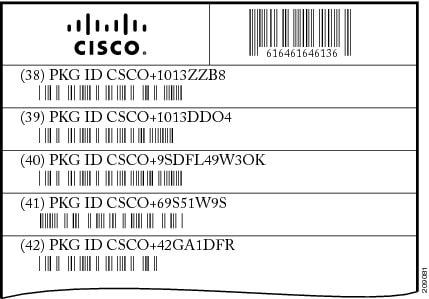


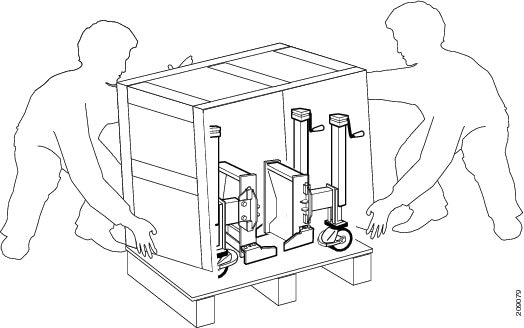
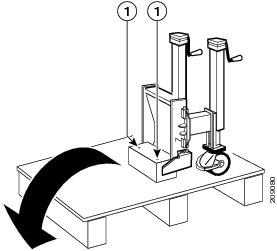
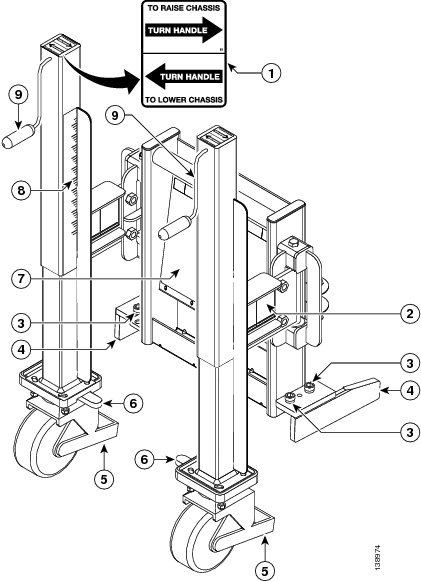
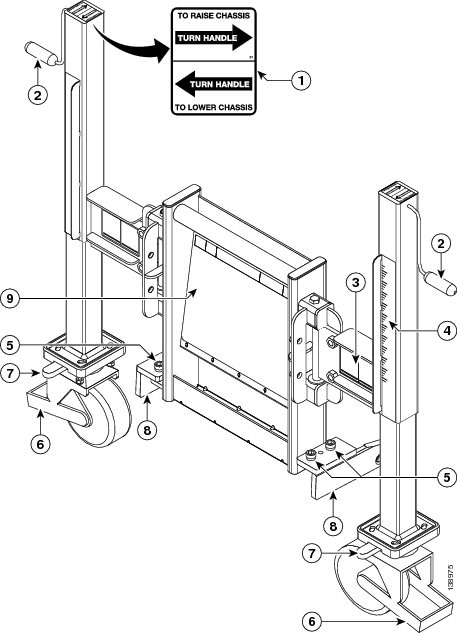
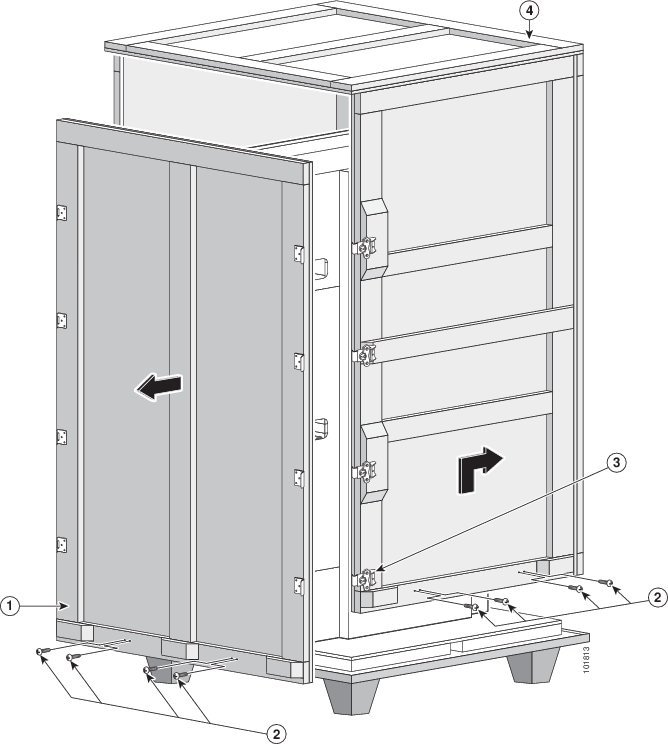
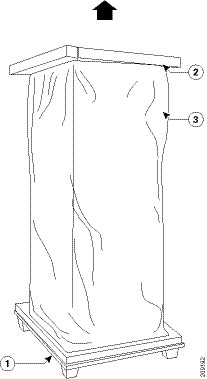
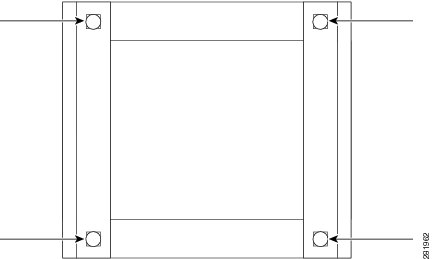
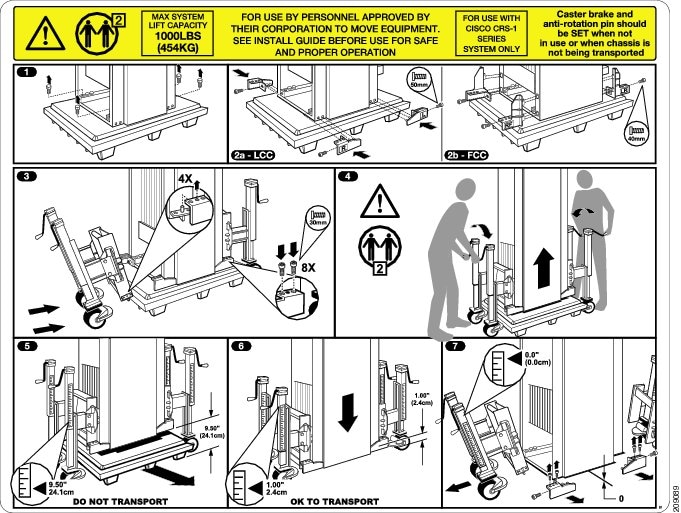
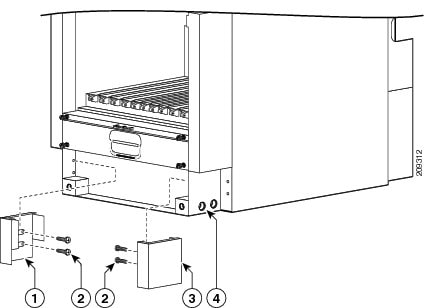
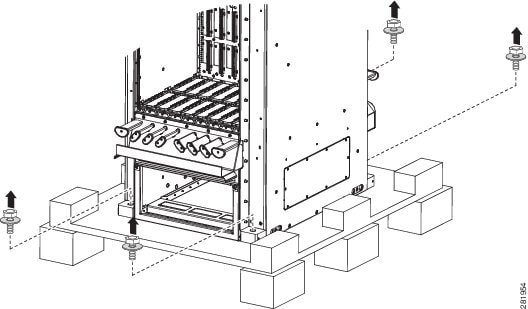
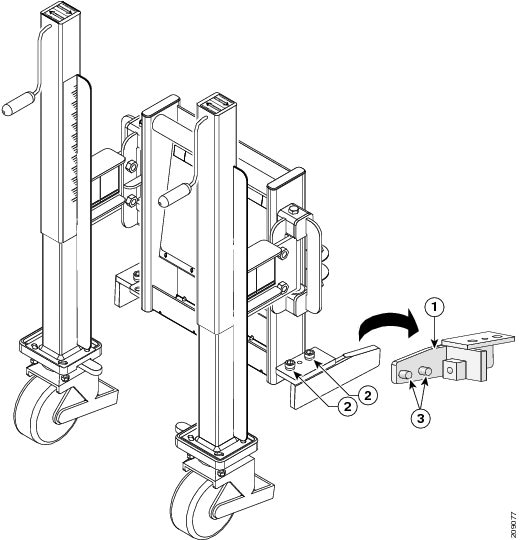
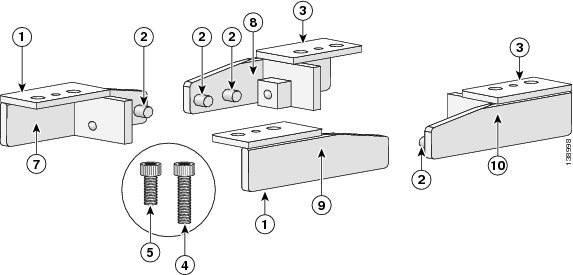
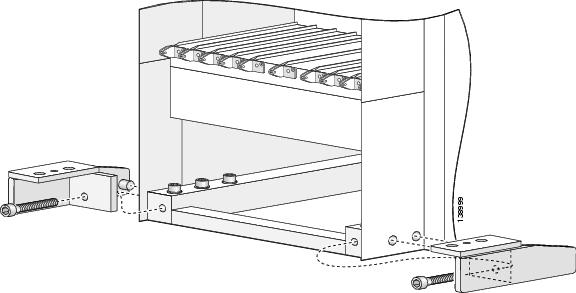

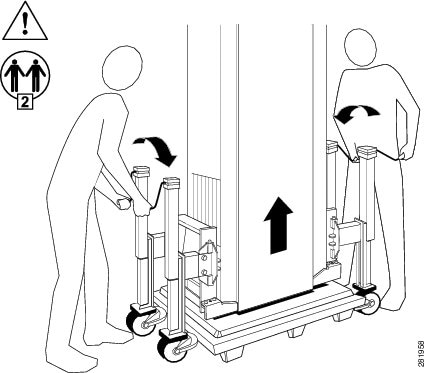
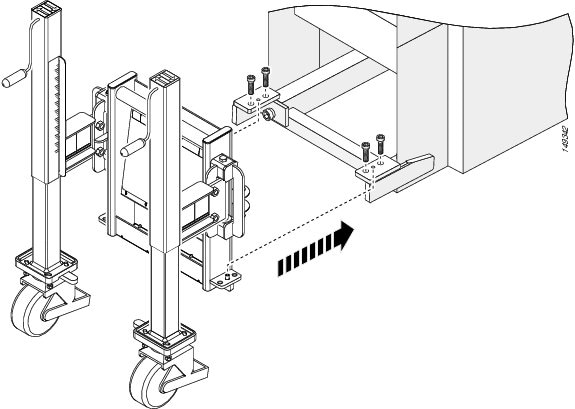

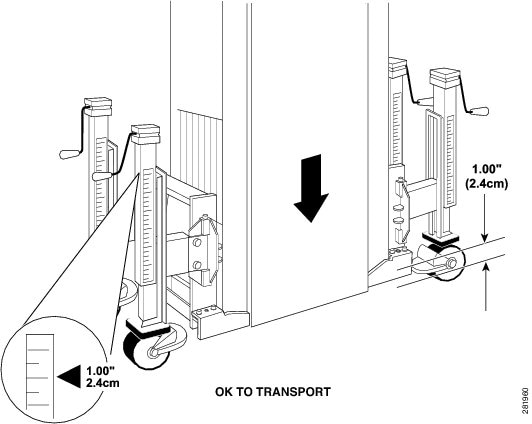


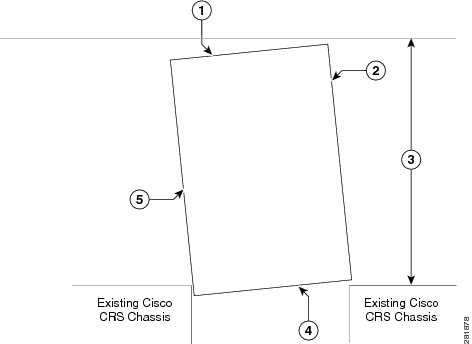
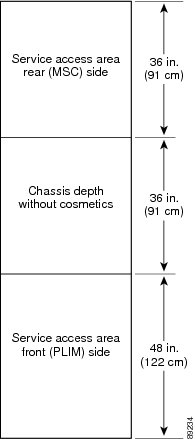
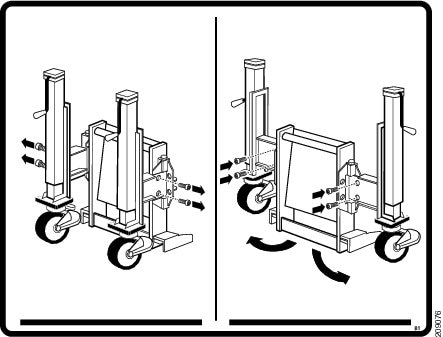
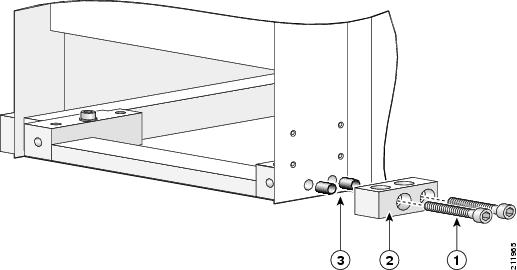
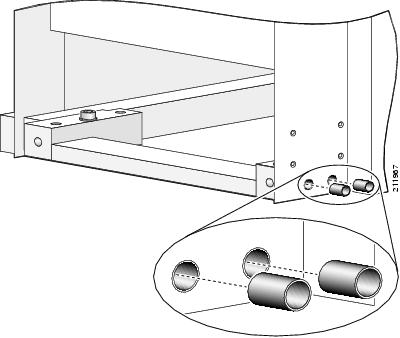
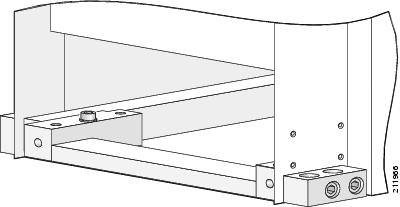
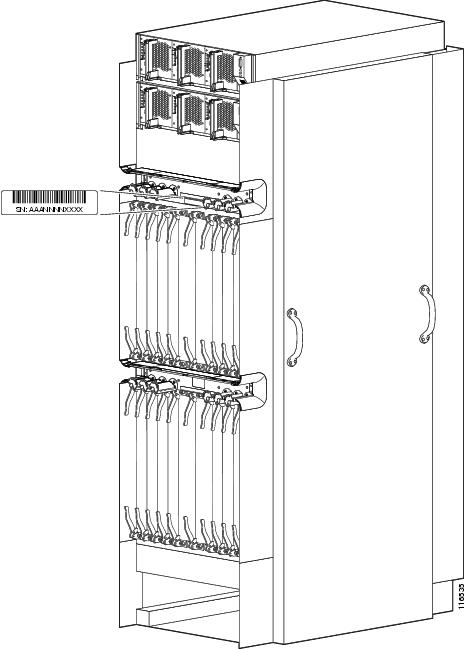
 Feedback
Feedback